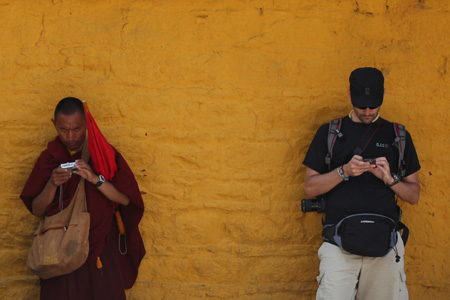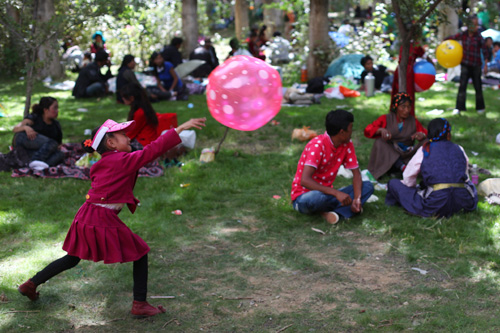Yogurt and dreams
|
|
|
Top: Drepung Monastery shows devotees the huge Thangka. Thousands of tourists flash their cameras to record the precious moment. Above: A lama and a foreign tourist share the same wall of Norbulingka to lean against and check electronic equipment. Zhang Tao / China Daily |
On the roof-top of the world, a celebration of faith and culture attracts both locals and visitors. In the face of advancing changes, Tibetans are still trying to hold on to their traditions.
Tibet draws the traveler like few tourist destinations do. Visitors take trains and planes up the mountainous heights to Lhasa with a reverence that borders on the religious, and makes a visit to Tibet come close to being a pilgrimage.
While the visitor skims the surface of both faith and culture during their brief stopovers, the average Tibetan takes these as part of daily life. To them, the various celebrations and ceremonies on their calendar are milestones for their families and children.
It is 5 am on August 10. The darkness of the night has not totally faded, but in the dim light of the street lamps, large crowds are already gathering as people pour out of their homes in Lhasa's crisp morning air.
A few miles away, thousands of devotees have already begun the steep ascent up the narrow, winding mountain paths leading up to Drepung Monastery.
Situated at the foot of the Mount Gambo Utse, 5 km away from Lhasa, Drepung is regarded as the most important monastery of Gelugpa (the "yellow hat" school) in Tibetan Buddhism.
Among the faithful is 39-year-old Yulo, who had got out of bed very early so she is assured of a vantage point for the ceremony that will come a couple of hours later.
But she is not one of the first on the hill. Some have already been there for a while, having set tents the previous day and waited through the night.
The cause of this enthusiasm is the eagerly anticipated ceremony called "Sunning of the Buddha".
As the sky lightens, the mountain begins to take shape. Tens of thousands have already congregated around the giant frame where a Thangka, or large tapestry of a religious icon, will be shown. There will be many perched around the most precarious slopes and boulders, just so to get a panoramic view of the Thangka.
Yulo's early efforts pay off and she secures a good position on the right of the giant frame, avoiding the crowds gathered at the foot of the hill.
Tibetan incense has long been burning and billowing smoke shrouds the mountain in a mystic mist.
Horns begin to blow and the crowd cheers as the huge Thangka with an image of Buddha is brought out from a low-lying building and carried up the ritual path by a hundred lamas and Tibetan devotees.
Many worshippers jostle along the route, trying to touch the blessed Thangka. Yulo waits excitedly while chanting prayers, and the two children with her seem also affected, more by the scene rather than the religious significance.
"There is a practical reason for the ceremony," explains Suonan Hangdan, the deputy curator of Tibetan Museum, "as the giant Thangka may suffer from mildew and damage if stored too long a time".
|
|
|
Tibetan Opera players perform for the public at Zongjiaolukang Park in Lhasa Aug 12, 2010. Visitors remain numerous on the third day of the Shoton Festival. Zhang Tao / China Daily |
"The unfolding of the silk covering the Thangka is supposed to coincide with the first rays of sunshine so the blessings of the Buddha can shine upon everyone," he adds.
It is a little overcast and the sun does not break through the clouds until a couple of hours later, but the ceremony goes ahead at 8 am, according to plan.
Once the Thangka is set, tens of thousands of white Khatags (traditional white silk scarves) are immediately tossed onto it. More will pave its path as it progresses down the hill.
"I feel blessed," says Yulo, who manages to touch the Thangka and walk around it clock-wise as Tibetan Buddhism dictates. "You will be blessed and happy all year round if you touch it."
She has been attending the ceremony since she was 21, when her family moved from Qamdo county , more than 1,000 km away from Lhasa. She would have liked to attend the ceremony even earlier but she was living too far away. That is why she has brought her own children this time.
Her 11-year-old son Awang Linba, is a student at Lhasa Third Primary School, and this is his first experience at the Sunning ceremony. But, he looks more tired than enthusiastic.
"I feel blessed, too," his 12-year-old sister Renzeng Zhuoga says. For her, this is the second time and the little girl seems more energetic than her sleepy brother.
As the most important ritual that heralds the seven-day Shoton Festival, the Sunning of the Buddha normally draws hordes of worshippers and visitors.
"I am still overawed by their devotion," says Pete Winn, a visitor from Colorado who first came to the ceremony five years ago. "But it seems like five times as crowded this year."
The Shoton Festival is the most celebrated festival in the Tibetan calendar, and is rivaled only by the Tibetan New Year. "Shoton" is a transliteration of the Tibetan words "yogurt" and "banquet", and marks the end of the monks' 100-day summer retreat from the end of June. When they come out, local residents will offer yogurt to the monks.
"Yogurt tastes best during this time of the year," says Suonan Hangdan, the deputy curator of Tibetan Museum. "It is also a food that denotes happiness and longevity in Tibetan culture."
It used to be an exclusively religious observance, until the 17th century. Tibetan opera was then incorporated into the celebrations and became a major part of the festival, playing for seven days in Norbulingka (literally the "Jeweled Park"), formerly the Dalai Lama's summer resort. All Tibetans, even prisoners, can watch the festivities.
This is where Yulo and her children will head after the "Sunning of the Buddha". They arrive at the park just before noon when the first performance of the opera begins. Hundreds have already gathered before them, forming solid walls of humanity around the makeshift stage.
"Now you can see why Shoton Festival is also called Festival of Tibetan Opera," says Yulo.
|
|
|
A girl plays on the grassland where throngs of visitors sit for rest.Zhang Tao / China Daily |
Tibetan Opera, or Ace Lhamo in Tibetan, is an ancient art form that has evolved over the centuries and is cherished by generations.
Developed and revised by Thangtong Gyalpo, a highly-respected Tibetan monk, it is a mix of indigenous drama, music and dance with vivid masks, colorful costumes, earthy dancing and rustic songs.
Often dubbed "the living fossil of traditional Tibetan culture," it is one of the oldest forms of opera in the country, being 400 years older than Peking opera.
"But it is still very popular today among Tibetans, compared with, say, the fading popularity of Peking Opera among some Han Chinese," says Liu Zhiqun, former deputy director of Tibet Ethnic Art Institute (TEAI), one of the nation's foremost researchers on Tibetan opera.
One of the factors sustaining Tibetan opera's popularity is its accessibility.
"Some monasteries and quite a number of major villages in Tibet boasts at least one troupe," Liu explains.
"Many troupes like us will perform free if the villagers are too poor to pay," says Migmar, impresario of Niangre Folk Art Troupe, a largely self-run village opera troupe, which is playing the afternoon's show.
That day, the drama is Prince Norzang, one of the best-known folk tales in Tibet and part of the eight great classical operas.
The most popular operas in the repertoire, including the well-known Prince Norzang and Princess Wencheng, are either based on Buddhist teachings or Tibetan history.
It is so much a part of Tibetan faith, culture and tradition that Tibetan opera goes wherever there are Tibetans.
Suonan Hangdan, deputy curator of the Tibetan Museum, agrees. Though "many people, the younger generation in particular, come to watch the shows only to bask in the festive atmosphere - rather than appreciate the opera itself," he adds.
Tibetan opera has been put on the United Nations Educational, Scientific and Cultural Organization (UNESCO) list of oral and intangible heritage of humanity in 2009, but it was not until the last decade that there was a general urgency to preserve this unique art form.
For one thing, Tibetan opera has traditionally been handed down from generation to generation through personal instruction. The death of an old artiste may mean the loss of one performance style, says Liu Zhiqun, the scholar with TEAI.
For another, although China has stepped up efforts to preserve Tibetan opera and spent millions to shore up village troupes and publish books and videos, money is still in short supply.
Village opera troupes perform only during the slack season or at major religious festivals and most performers do not get regular monthly remuneration. Fees from occasional performances barely cover living and travel expenses and this discourages the young from taking up the art.
But although the shortage of funds plagues his troupe every now and then, Migmar, the impresario, is more optimistic. His actors have been receiving monthly wages since 2003, the highest-paid reaching 2,000 yuan and lowest-paid 600 yuan.
But obviously, it was still not good enough for some.
In 2008, 19 members of his troupe, all trained and groomed by his father at a very young age, left for either higher-paid troupes or singing-and-dancing clubs gaining popularity in Tibetan cities, only a week before the Shoton Festival. His father suffered a fatal heart attack shortly after.
But there are also those who truly love the art: 25 original members have stayed faithfully on since the troupe was founded in 1983, and it has also managed to recruit 19 new members, all between 13 and 21, in the past two years.
"They never complain about money," Migmar says. "And there are many people out there who genuinely care about Tibetan Opera." That's why he can still get generous sponsorships.
Yulo quickly withdraws herself from the crowd before the proper part of the drama barely starts."We all know the story and the plots pretty well," she says. "But we cannot understand some of the singing. I think we kind of just lost touch through the years."
"Even if I could sit in the front rows, I couldn't stand the long, slow-moving drama."
A Tibetan opera usually lasts for six hours, with some playing a whole day or even three.
Her children's attention has already shifted to "Guo Lingka", which literally means "spending the lingka" or "living the lingka", and is essentially camping and having a picnic.
They have set up the blanket and food they brought with them at a nearby meadow. "Guo Lingka" is definitely more fun for them. And tents and blankets can be seen everywhere there is green grass.
"Lhasa has the best weather and scenery during this time of year," explains Puzhi, head of the cultural relics section of the Norbulingka Administration Office. "It is the ideal time to go out and embrace nature."
A total of 230,000 people swarmed into the 360,000 square meters of Norbulingka during last year's Shoton Festival and most were local residents watching Tibetan Opera or camping on the grass, according to Nyima Tenzin, director of the park's administrative office.
For Yulo and her children, the seven-day holiday is to celebrate their faith, and to enjoy nature and traditional Tibetan performances.
"For them, all this looks interesting or even strange," she says, referring to camera-toting visitors clicking furiously away. "But to us, it's just our way of life."
 0
0 











Go to Forum >>0 Comments